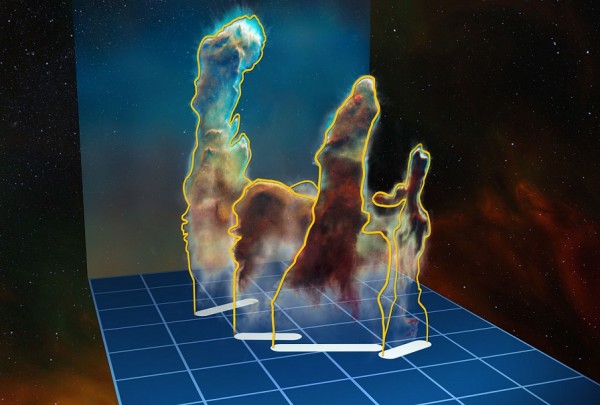Pillars of Creation Disappearing? New 3D View Reveals How
| Ana Verayo | | May 01, 2015 02:41 AM EDT |
(Photo : ESO/M. Kornmesser) This visualisation of the three-dimensional structure of the Pillars of Creation within the star formation region Messier 16 (also called the Eagle Nebula) is based on new observations of the object using the MUSE instrument on ESO’s Very Large Telescope in Chile.
Scientists have revealed the newest image of the Hubble Space Telescope's iconic Pillars of Creation in 3D that suggests that these gas cloud protrusions will be gone after three million years, which is a short amount of time in astronomical terms.
These new images show never before seen stars amidst the thick, cosmic gas clouds including incredible details about their structure and orientation in space. Astronomers released these new details along with a new video about the formation of the Pillars of Creation.
Like Us on Facebook
The Pillars reached worldwide fame when the Hubble Space Telescope captured this glorious formation in 1995. Hubble also released a high definition of the image and other objects in the region during its software update.
The finger like cosmic protrusions are made from hot dust and gas which are part of a bigger region in the Eagle Nebula which is a fertile region, a nursery of sorts for new star formations some 7,000 light years away.
The hot and massive infant stars are so powerful and energy dense that they burn into gas clouds in the nebula, sending out emissions of strong stellar winds and radiation waves that disperse these gases.
However, those gas pockets can tolerate these intense energy star forming regions especially their radiation and stellar winds. These pockets can shield the gas that hides behind it resulting in these pillar like regions of star formtions where astronomers often observe as column shaped gas clouds.According to the European Southern Observatory, these are also called tails or elephant trunks as well.
As these powerful winds and radiation push down these shields of dense gas, the Pillars of Creation were spawned from this energy from infant stars. Astronomers can now measure the rate of how the Pillars of Creation are slowly being eaten alive by these gas clouds using the MUSE (Multi Unit Spectroscopic Explorer) instrument which is attached to the ESO's Very Large Telescope in CHile.
The readings reveal that the Pillars are losing energy 70 times the mass of our sun every one million years. It is estimated that the Pillars contain about 200 times the mass of the sun and if this rate still continues, astronomers believe that these majestic gas clouds will evaporate and disappear forever in 3 million years.
This study is published in the Monthly Notices of the Royal Astronomical Society.
Tagspillars of creation, Hubble Space Telescope, ESO, 3D view pillars of creation
©2015 Chinatopix All rights reserved. Do not reproduce without permission
EDITOR'S PICKS
-

Did the Trump administration just announce plans for a trade war with ‘hostile’ China and Russia?
-

US Senate passes Taiwan travel bill slammed by China
-

As Yan Sihong’s family grieves, here are other Chinese students who went missing abroad. Some have never been found
-

Beijing blasts Western critics who ‘smear China’ with the term sharp power
-

China Envoy Seeks to Defuse Tensions With U.S. as a Trade War Brews
-

Singapore's Deputy PM Provides Bitcoin Vote of Confidence Amid China's Blanket Bans
-

China warns investors over risks in overseas virtual currency trading
-

Chinese government most trustworthy: survey
-

Kashima Antlers On Course For Back-To-Back Titles
MOST POPULAR
LATEST NEWS
Zhou Yongkang: China's Former Security Chief Sentenced to Life in Prison

China's former Chief of the Ministry of Public Security, Zhou Yongkang, has been given a life sentence after he was found guilty of abusing his office, bribery and deliberately ... Full Article
TRENDING STORY

China Pork Prices Expected to Stabilize As The Supplies Recover

Elephone P9000 Smartphone is now on Sale on Amazon India

There's a Big Chance Cliffhangers Won't Still Be Resolved When Grey's Anatomy Season 13 Returns

Supreme Court Ruled on Samsung vs Apple Dispute for Patent Infringement

Microsoft Surface Pro 5 Rumors and Release Date: What is the Latest?










